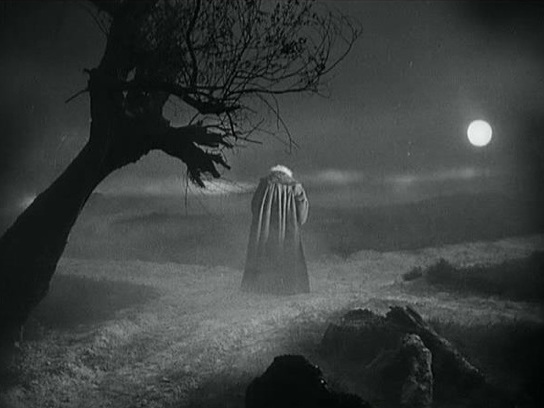FAUST
Friedrich Wilhelm Murnau (DE 1926)
When Murnau left Berlin for America in June 1926, he reportedly took a print of Faust with him, which he was to hand over to Ufa’s U.S. representative Frederick Wynn-Jones upon his arrival in New York. Fox’s press spokeswoman Vivian Moses vehemently denied the announcement made by the Los Angeles Times on June 19, which stated that Murnau was completing his final cut of Faust at M-G-M’s studio in Culver City. Murnau was under exclusive contract to William Fox and would be devoting his full attention to a film adaptation of Hermann Sudermann’s 1917 short story “Die Reise nach Tilsit” (“The Journey to Tilsit”). Back in Germany, Ufa manager Hans Neumann had contacted celebrated author Gerhart Hauptmann with a plea to revise the sloppy intertitles that had been featured in the work print of Faust. Hauptmann refused at first, only to later change his mind after seeing the film at a special screening in Stralsund and after Ufa had doubled its initial offer. Hauptmann postponed work on his play Dorothea Angermann in order to bring the “precious film work” to a fitting conclusion; its commercial viability, so he thought, seriously at risk if he didn’t.
On August 23, the daily newspaper B.Z. am Mittag published extracts from Hauptmann’s rhyming intertitles. For the preview screenings simultaneously scheduled in Berlin, Hamburg, Frankfurt, Düsseldorf, Leipzig, Breslau, and Munich two days later, it was already too late for the new titles to be added to the prints. Hans Kyser, the author behind the film’s screenplay, subsequently wrote a polemic against Hauptmann’s involvement on the film in the form of an open letter, subheaded “On the Disagreement Surrounding the FAUST Titles,” which was published in B.Z. am Mittag on September 1. Although he admitted to not having seen the film with Hauptmann’s titles, Kyser was nonetheless concerned that due to the very fact they were written in rhyming verse the film would be imbued with a “literary character” that would deter from the “visionary strength of its visual composition”. Virtually every newspaper and magazine subsequently printed Kyser’s letter, offering their own responses on the subject of Hauptmann’s rhyming titles in the process. Following an internal screening of Faust with Hauptmann’s titles, Ufa manager Neumann contacted Hauptmann’s wife Margarete and urged her to talk her husband round to “revising” and “popularizing” his “deeply profound” rhyming titles for Faust: “By the time the small percentage of the audience that is even capable of thinking has finally understood the verse, the film has already progressed a further 300 ft.” Neumann bragged that for several years his closely held belief had been that “the mindset of the cinema-going audience is equivalent to an eight-year-old child’s.” Hauptmann did not accede to Neumann’s request.
At the start of October, Ufa announced that Hauptmann’s titles would ultimately not feature in the film, but would be published in the accompanying program brochure for the premiere screening at the Ufa Palast am Zoo in Berlin on 14 October. The fact that the film was submitted to the German film censor’s office in Berlin twice, on 17 August 1926 and again on 26 October that same year, suggests that the film underwent further revisions during this period. No less than 36 at times vastly differing changes are evident if one compares the existing intertitles of the work print most likely presented in preview screenings with the so-called “Kyser titles”, as well as the wording of the titles recorded on the surviving second screening permit issued by the German censor’s office, which most likely corresponds to the version screened at the Berlin premiere.
It is not clear whether the film was ever publicly screened with Hauptmann’s titles. In its trade advertisements, Parufamet mentioned the fact that the “debates” surrounding Gerhart Hauptmann’s titles for Faust had penetrated even the most remote areas. Newspaper advertisements for the Estonian premiere of Faust, which took place in Tallinn on 2 December 1926, made explicit reference to Hauptmann’s name. It therefore cannot be ruled out that Hauptmann’s titles may have served as the basis for translations into certain foreign languages.
This reconstruction of Faust featuring Gerhart Hauptmann’s titles is based on a scan of a print of Luciano Berriatúa’s 1997 reconstruction of the original German version. Shots marred by “jump cuts” due to the addition of extra intertitles have been substituted from a print made from the alternative negative that was assembled in 1932 for the film’s re-release in Germany. Occasional continuity errors have also been corrected. The division of the film into two distinct parts following explicit indications in Murnau’s original shooting script has been respected with the addition of a corresponding title card, as well as in the new score by Richard Siedhoff. The sophisticated English translation of Hauptmann’s titles was done by Elizabeth Tucker.
Stefan Drössler


regia/dir: Friedrich Wilhelm Murnau.
scen: Hans Kyser, dalla sceneggiatura/based on the script “Das verlorene Paradies” [Paradiso perduto] di/by Ludwig Berger, basata su fonti di/based on sources by Johann Wolfgang von Goethe, Christopher Marlowe, et al.
photog: Carl Hoffmann.
scg/des, cost: Robert Herlth, Walter Röhrig.
cast: Gösta Ekman (Faust), Emil Jannings (Mephisto), Camilla Horn (Gretchen), Frida Richard (la madre di Gretchen/Gretchen’s mother), Wilhelm Dieterle (Valentin), Yvette Guilbert (Marthe Schwerdtlein), Eric Barclay (Duca di Parma/Duke of Parma), Hanna Ralph (Duchessa di Parma/Duchess of Parma), Werner Fuetterer (Arcangelo/Archangel).
prod: Universum Film-AG (Ufa), Berlin.
dist: Parufamet.
uscita/rel: 14.10.1926 (Ufa-Palast am Zoo, Berlin).
copia/copy: DCP, 109′; did./titles: GER, subt. ENG.
fonte/source: Filmmuseum München.




